#budapester straße
Text
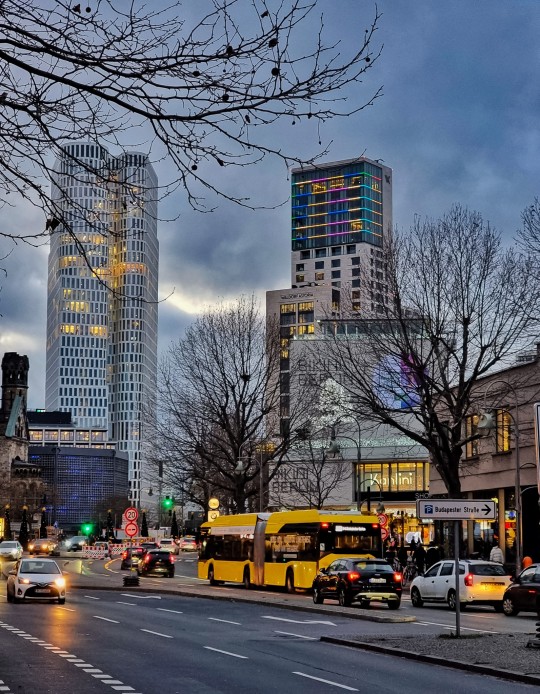

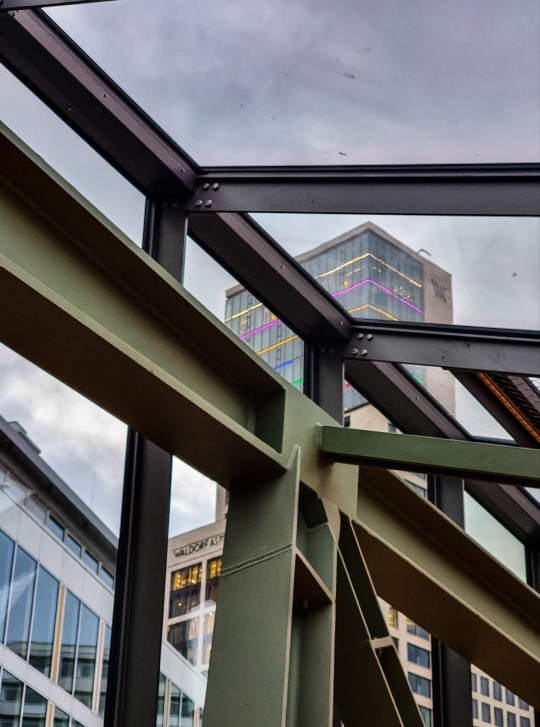


#berlin#city west#Hotel Motel One Berlin-Upper West#Waldorf Astoria Berlin#Bikini Haus#Budapester Straße#Statik
12 notes
·
View notes
Text

Das Hochhaus. / 07.09.2023
#Berlin#Charlottenburg#Budapester Straße#Architektur#Architekturfotografie#Waldorf Astoria Berlin#2023#2023September#2023September07#Waldorf Astoria
3 notes
·
View notes
Text
International demostration for the captive defenders of Mariupol - June 25th!
‼️ Post last UPDATED with new locations on June 24! More countries and locations have been added. It is alphabetized by countries, find yours!
Please pay attention that while most of the demonstrations will be held on June 25, some are on June 26 - those special cases are highlighted in the list. ‼️
Peaceful demonstrations with the motto «Azovstal. Free Mariupol defenders» will take place all over Europe on Saturday, June 25th (and some, on June 26th). List of cities below. Please come if you can, and share the information.
The purpose is to save the defenders of Mariupol from torture and brutality while they are held prisoners by russia, and to help them return home as soon as possible. This is a plea of every Ukrainian, and the world must hear it.
We need to remind the world about our captive heroes, to draw the attention of international organizations to the conditions they are held in, to ensure their situation is monitored by international community.
Below is the list of cities where demonstrations will be held. If your city is on the list - please come to support Ukrainian heroes, and invite people to come with you. If not - I ask you to share the information, and possibly contact your local organizations to see if you can gather in your city too.
Australia 🇦🇺
Customs House, Sydney, NSW
26.06 (‼️)
14:00
Austria 🇦🇹
Maria-Theresien-Straße 18, 6020 Innsbruck
17:50
Canada 🇨🇦
Yonge-Dundas Square, then walking to 200 Bay St, the office of the United Nations in Toronto
14:00
Chile 🇨🇱
Av. Américo Vespucio Norte 2127, Vitacura, Santiago de Chile
12:00
Cyprus 🇨🇾
Harbour Kiosk, Paphos
18:30
Czech Republic 🇨🇿
Piaristicke náměstí, České Budějovice
12:00
AND
Czech Republic 🇨🇿
Palackého náměstí, Prague
17:00
Georgia 🇬🇪
29 Memed Abashidze Ave, Batumi
18:50
Germany 🇩🇪
Bundeskanzlerampt, Berlin
13:00
AND
Rathausmarkt, Hamburg
15:00
AND
Hauptwache, Frankfurt
19:30
Hungary 🇭🇺
Szent István tér 1, Budapest
19:00
Ireland 🇮🇪
Statue of Richard Harris as King Arthur, Bedford Row, Limerick
18:00
Italy 🇮🇹
Piazza del Duomo, 20123, Milano
18:00
Japan 🇯🇵
Shinjuku, Shinjuku Station South Exit, Tokyo
26.06 (‼️)
16:00
Malta 🇲🇹
Triton Fountain, Valletta
19:15 (‼️updated time‼️)
The Netherlands 🇳🇱
De Verwoeste Stad, 3011 EA, Rotterdam
12:00
AND
Peace Palace, Carnegieplein 2, 2517 KJ, Den Haag
12:00
AND
Dam Square, Amsterdam
17:00
Norway 🇳🇴
Eidsvolls plass, Oslo
12:00
Poland 🇵🇱
Pasaż Schillera ul. Piotrkowska 110, Lódź
16:00
AND
Rynek Główny, Pomnik Adama Mickiewicza, Kraków
19:20
Portugal 🇵🇹
Praça de Gomes Teixeira, Porto 18:50
AND
Praça do Comércio, Lisbon ‼️26.06 ‼️19:30
Romania 🇷🇴
Piața Sfatului, Braşov
11:30
Slovakia 🇸🇰
Podchod Hodžovo námestie 2978 811 06 Bratislava
13:00
Spain 🇪🇸
Josefina De La Torre Municipal Library, Gran Canaria
11:30
AND
Plaça de la Verge, 4, 46001, València
26.06 (‼️)
13:30
Sweden 🇸🇪
Norrmalmstorg, Stockholm
12:00
Switzerland 🇨🇭
Place des Nations, Genève
12:00
AND
Rathausbrücke, Zürich
16:00
Turkey 🇹🇷
Odakule Business Center, Istanbul
14:50
United Kingdom 🇬🇧
Grey’s Monument, Newcastle upon Tyne
12:00
AND
Piccadilly Gardens, Manchester
14:00
AND
Cardiff Central Library CF10 1FL, Cardiff
14:00
AND
10 Downing St SW1A 2AB, London
15:50
United States of America 🇺🇸
50 W Washington St, Chicago, IL 60602
14:00
Mottos of the demonstrations:
- Azovstal. Free Mariupol Defenders
- Be brave like Azovstal
- Freedom for Mariupol heroes
- Freedom for Azovstal defenders
- Respect the Geneva Convention
- Protect the rights of prisoners of war
- Give access to the Red Cross
- We are waiting for our heroes
Source: Families of Azovstal Defenders Association https://www.facebook.com/AzovstalFamilies/posts/pfbid02dpMN84hFJLK3hUEf7x4ugwAi49VLnjStJ2ssqJ8vGajkmMgoB7W8DDRBs8HpD26Yl
91 notes
·
View notes
Text
Friday 31 July 1998 - Night at the Rustler (W-Penzing) - guided by Franz Kaida’s voice - eating pizza rectangles in Schottentor - finally can take photos with the new camera
Friday 31 July 1998
Grüß Gott und Servus!
Today twenty years ago marks the end of what is known as the Alte Rechtschreibung in German. The Neue Rechtschreibung is the new orthography of German, which is not limited to just spelling but also punctuation. I will tell more about it later on but that is one of the big news items of that day.
https://en.wikipedia.org/.../German_orthography_reform_of...
This will be the first of three days heading eastward, possibly the farthest east from München I have ever been (Istanbul Sirkeci station in Turkey to date is the farthest). I will be going to Vienna, then Budapest, then return stopping at Vienna Westbahnhof - the Hauptbahnhof next to Südbahnhof was not constructed and opened until 2016. So here is the overview of what I did on Friday 31 July 1998.
- woke up about 7 AM from apartment
- swung by the SSKM in Marienplatz to withdraw ATS 500 notes
- arrived at München Hbf about 8:45 AM in time to find my Sommer Spezial car and reserved seat in 1st class
- crossed into Austria about 10:30 AM, arrived in Salzburg around 10:45 AM, DB staff changed to ÖBB
- a miracle with the camera happens about 12:15 PM, have lunch in the dining car to celebrate
- arrive at Vienna Westbahnhof about 1:30 PM, try to find a hotel as the youth hostels are booked up
- leave clothes bag at hotel room, walk to Johnstraße U-Bahn station
- take U-Bahn to Prater via Philadelphiabrücke/Meidling station, end up at Prater by S-Bahn
- take a trip down memory lane at the Prater, see the large Riesenrad Ferris Wheel
- go into central Vienna with the U-2 via Schottentor. Have pizza slices before making the transfer
- listen to FM4 La Boum de Luxe and hear a bit of "Mo Betta Blues" Denzel Washington "What the world needs now (is *not* another love song)!"
- take a tram tour to the Upper Belvedere, just get postcard of "der Kuss" by Gustav Klimt
- stroll along to Stephansplatz and admire the multicolored tiled roof.
- have a cup of Segafreddo coffee, go to Westbahnhof to buy a phrasebook with Hungarian
- take U-3 to Johnstraße and bus 51 to Linzer Straße
- listen to Hit Radio Ö3, read phrasebook and go to sleep
Okay, are you ready to have fun in Vienna?😀😃😄🇦🇹
Let me give you some background on Vienna. Unlike Zürich, which I could remember from a relatively recent visit, I had only been to Vienna once as a young child. I barely even remember what I did there. I had to study maps so that I would have a general idea of what to see. I also had a German-language guidebook on Vienna, which included vocabulary not otherwise used in Germany, or even in most parts of Austria for that matter. The one map I needed to familiarize myself with, was the U-Bahn system. I think I did fine overall. Oh, and at work, everyone knew in advance that I was taking Friday the 31st July off, so it was no problem.😀
As the last weekend in July is usually the time that Bavaria and Austria are let go for the summer holidays, it was impossible to book a bed in any youth hostel. I had to improvise, but I did not know of any hotels in Vienna, so I went without any reservation - very unusual for me, given my custom of prior booking in advance. So with an open mind, I woke up (I forgot to do something important but could not remember what) about 6:30 AM, took my shower to avoid clashing with the roommates schedules, had a quick breakfast with coffee and then took the bus and U-Bahn into Marienplatz. The Stadtsparkasse had ATMs that would give 🇦🇹 ATS bills, for example the 500 ATS. This was worth about € 36 or around 71 D-Mark each. On the front was Rosa Mayreder who replaced Otto Wagner. https://upload.wikimedia.org/.../155px-500_Schilling_Rosa.... This was a new and possibly last pre-Euro series. Moritz Daffinger and Sigmund Freud among others would still be visible on their respective notes. I think I had withdrawn about 2,500 ATS, more than enough for the weekend. And it was time to head to München Hbf.
I had a Sommer-Spezial ticket for Vienna, 89,00 D-Mark for one way in first class, quite a bargain, but with the "usual strings attached". I also had my Eurail Pass which I was going to use on 1st and 2nd August. I found the train car and it was full, I was the last to arrive. The train left about 9:10 AM. I had the radio going,📻🎧 listening to Bayrische Rundfunk 3 aka Bayern3 (which I listened to the most during Summer 1998). I think about Aying the signal was getting weak so I switched to the Rosenheim repeater frequency. It worked for a while until Traunstein. If you have been between München and Salzburg, you can likely imagine you are first going through a fairly flat forest land up to Rosenheim, then slightly hilly terrain up to Freilassing with mountains to the south, with a couple of lakes (eg. Chiemsee). It is the same trajectory I took 20th and 21st June 1998.
At Freilassing, the Hit Radio Ö3 station could be heard clearly. After it played "Everybody" by DJ Bobo, the announcer was mentioning the Lassing mine disaster in the Steiermark - https://en.wikipedia.org/wiki/Lassing_mining_disaster. It happened 17 July and I heard about it first on 24th July when I was trying to tune in the DRS channels while in Lindau/Bregenz. After that, the train rolled into Salzburg to change the locomotive from DB to ÖBB to go the rest of the way to Vienna Westbahnhof. The train would not change direction until then.
The train stopped at Attnang-Puchheim, then went on to Linz and St Pölten. I was trying to take photographs with the point and shoot camera I bought in Milan. Until then I did not know the technique to properly thread in the film, so I had been just clicking the button and turning the thumbwheel, and all the while the counter went up to 36 shots and I had no idea. Then I had a fresh roll of film that I opened, opened the back, and then there was a slot with a tooth that I should have put the film in, so I did that, and the next thing I knew, there was resistance with the frame advance thumbwheel, and I thought I had mastered the camera. I took a few shots of the rear of the train (it turned out that the slot was the secret). 😃To celebrate this "victory", I treated myself to a chicken lunch in the dining car.😋 I had the chicken plate with vegetables including red bell pepper and some quinoa-like grain with an Austrian beer. I think it cost only 350 ATS altogether. I had to be careful with my finances thereafter, as I did not know, how much the hotel would cost for the night.
When I arrived at Vienna Westbahnhof, it was about 1:30 PM. I thought there would be some directory for hotels, but there was this office that would take care of travellers so they found a low-budget hotel for me in the Penzing district, about a 15 minute tram ride away. I would stay at Hotel Rustler, on Linzer Straße 43, close to Johnstraße and reachable by bus, but had to take care of the local transit fares first. I bought a 24 hour ticket for 80 ATS. I took the tram to Linzer Straße, and the hotel seemed a bit spooky. 😱 The man took my 350 ATS and gave me a towel. My room was a single bedroom and had only a sink but no toilet and no shower. Breakfast was included. At least I would have some quiet at night. I left my clothes bag there and went into the city center.
I wanted to see the Prater, so I went on a southern approach, kind of through the current Hauptbahnhof which did not exist until 2015 or so. I did not wait for the bus so I decided to walk to the Johnstraße U-Bahn station. In Austria cars can have personalized plates, prepended by the district code to which it is registered. One rich guy who owned a Vienna-registered 🚗 Corvette had "W-HALCO" as his personalized plate, I am not sure where the photo of it is anymore. At a park along the way, there was a sign "Wer Tauben füttert, füttert auch Ratten" (If you feed pigeons, you also feed rats). 🕊=🐀
Probably 25 minutes after I left the hotel, I arrived at Johnstraße. The station was the current western terminus of the U-3, and before passing the ticket cancellation machines, there was this grotesque figure called the "Hudriwudri", and stood atop a circular ashtray to remind passengers to not smoke in the station 🚭 and also in the train. The Hudriwudri wears very little, aside from a homburg hat, circular glasses, a purple and pink necktie and purple shoes. Passing the Hudriwudri, I went downstairs to the platform where U3 would go to Westbahnhof and change to the U-6 and do the anticlockwise circle to the Prater. There was a train waiting. As it departed and headed to Schweglerstraße and on to Westbahnhof, I heard the next-station announcement with the same voice as the tram, following a bing-bong chime. Almost every time, the voice would also announce the line transfers where applicable. For busses and trams, he would sometimes say "Kurzstreckengrenze" to announce the end of a current discount fare zone, and sometimes "Wir bitten Sie, an älteren oder behinderten Fahrgästen, sowie Personen mit kleineren Kindern, Sitzpläte zu überlassen." to ask passengers to give up their seats to the elderly, disabled and mothers/fathers with young children. His voice seemed a bit monotone. I would find out later the name of the person doing the voices, and he had been doing that from approx 1976 to 2012 when he retired.
After arriving at the U-3 platform for Westbahnhof, I took the passage to the U-6 platform. The U-6 was built as a low-floor tram originally and was subsequently refurbished to subway standards. The U-6 was kind of like a roller coaster ride between Westbahnhof and Längenfeldgasse since the Otto-Wagner-designed Gumpendorfer Straße station was elevated while the rest were underground up to Philadelphiabrücke/Meidling. Meidling is an intermodal transfer stop for S-Bahn and the U-6. The S Bahn as well as the "Wiener-Baden Bahn" was on the surface. Waiting for the next S-Bahn to the Praterstern, it took about ten minutes as it was not yet the beginning of the evening rush hour. The train came and made its way past Matzleinsdorfer Platz, the former Südbahnhof which became Hauptbahnhof, the Belvedere, Wien Mitte commuter rail station and finally Praterstern. Praterstern is like a Coney Island, less so a Six Flags park. Admission is free of charge, rides require tickets, including the famous giant ferris wheel. 🎡🎢 https://en.wikipedia.org/wiki/Vienna....
When I walked through the Prater, it was like my previous visit in 1976. The one thing I remember from that time, was the pony ride, so I stopped by. There were a few roller coasters, fun-houses, the Liliputbahn, a gravity drop thrill ride, . There even were a few currency exchange places around the Prater. They accepted many eastern European currencies to change to the Schilling, particularly the Czech Koruna, Slovak Koruna, Hungarian Forint, Yugoslav Dinar, Polish Zloty, Romanian Leu, Bulgarian Lev and many more. One place in the Prater that I wish I went, was the Schweizer Haus. https://www.schweizerhaus.at/menu.asp. That is Vienna's best beer garden. Pretty much anything you might find in Germany, is served here as well but with a Vienna twist. This includes the famous Vienna Sausage known as "Frankfurter", Bratwürstel, Gulasch, Schnitzel, Sauerkraut and the grilled half-chicken, Oktoberfest-style. They can slice up a fresh white radish, and make their own potato chips in-house. Powidltascherl are essentially pierogies. Mohnnudeln are dumplings with ground poppy seed topping. As for beer, they have proper Czech Budweiser, Gieskirchner and Paulaner Hefe. At some point I hope to eat at the Schweizer Haus, next time I visit Vienna. 😋🇦🇹
I wanted to see more of Vienna after the Prater. To go back to the center, particularly Karlsplatz, I would need to take the U-1 to Schwedenplatz, then U-4 and U-2 to Schottentor. Schottentor has an interesting tram stop which has its lower level exposed as a departures platform. I bought some pizza, one with ham and mushrooms, and the other a spinach and fried egg, and I ate it at the stop, since eating was not necessarily prohibited at the station, but it was frowned upon in the trams. I then went on the U-2 to Karlsplatz to have a look around. Karlsplatz is where the famous Opera building is located, great for ballroom dancing events and professional performances.
I thought after seeing Karlsplatz, it would be a good time to go on a surface tram tour around the city center. The lines 1 and 2 run along the former location of the city wall. I went clockwise on line 1 to Schottentor, passing the Parliament and Rathaus. Then I changed direction, took the tram 1 to Volkstheater and changed to line 2. I went to about Schwarzenbergplatz so that I could see the Schloß Belvedere. This is where many of Gustav Klimt's works are stored. I would return in January 2002 to see his works, including "Der Kuss". I even bought a postcard for a professor who liked Klimt's works, and she let me know when it arrived in the USA (I think 5th-6th August 1998). And after that, I went through the Stadtpark to Johannesgasse, then along the Kärntnerstraße (both pedestrian zones) to the Domkirche St Stephan. This cathedral was built in the 14th Century AD in the gothic style with some romanesque elements here and there. Its roof is one of the most interesting of all cathedrals I have ever seen, namely on the top there are black, grey, green and white tiles, and in the stripe below there are black, yellow, green and grey in sort of a diamond shape. One side has two eagles, one with the shield of the Republic of Austria and the other with the shield of the city of Vienna.
After seeing the ⛪ Stephansplatz, I needed to go to the 🚉 Westbahnhof rail station to buy a🛒📕 phrasebook, hopefully there would be one for Hungarian, even if written for German speakers. Vienna is close to two other countries so it would seem logical. But before that, I somehow felt the need to have an espresso, as coffee houses are so common in Vienna. I found one that featured Segafredo coffee. I had a cup of espresso and I think also a small cookie about the size of a pink eraser. And an 8 ounce glass of water to go with that. ☕+🥛+🍪 During the time I was enjoying my evening espresso, I was listening to the FM4 La Boum de Luxe show in "Denglish", namely alternating between English and German. They even played a section of Mo Better Blues when Denzel Washington as Bleek Gilliam singing a spoof of Jackie DeShannon's "what the world needs now", and he said mockingly "is *not* another love song!". FM4 is still broadcasting even in 2018. After that it was time to head to the rail station before the shops would close for the day.
The journey from ⛪ Stephansplatz to Westbahnhof would be fairly simple. Get on the U-3 and stay on for five stations and head to the national railways. I left the radio on and recorded just static for the time I was underground, so however long it takes to get from Stephansplatz to Westbahnhof by the U-3, that is as much white noise as I recorded. What I wanted to record, was the voice of the subway announcer but that did not work until I went from Westbahnhof to Johnstraße. But I was not ready, I had to go to a bookshop to buy a phrasebook. 📕🛒 The only relevant phrasebook available was "Osteuropa", it had enough Hungarian for my purposes. Other languages included Albanian, Bulgarian, Croatian, Czech, Slovak, Slovene, Romanian, Polish, Estonian, Latvian, Lithuanian and Russian. It was written for German speakers, so I had to learn to speak from a German point of view rather than my natural US English view. The book was bought, and then it was time to go back to the hotel.
I only had to take the U-3 to Johnstraße and the bus 51 to Linzer Straße to get to the hotel. Once I arrived, I went to my room and read through the phrasebook to try to learn some phrases, like "jó napot", "kerem" and "köszönöm". Hungarian has about nine vowels and almost 30 consonants, some of which require two letters. For example, the letter S is pronounced as "Sh" and SZ is pronounced as "S". The letters Ö and Ü are essentially the same as in German but there long and short versions, German uses a short Ö and Ü by default and to lengthen it, the letter "h" is used, like "öh" and "üh", but in Hungarian, something like a double acute accent is used, as Ő and Ű. Another consonant that is difficult for most to pronounce is "gy". It sounds something like a short "dzyerh". From Wikipedia "The sound voiced palatal plosive / ɟ /, written ?gy?, sounds similar to 'd' in British English 'duty' (in fact, it is more similar to the Macedonian phoneme ' Ђ ' as in '?????'). It occurs in the name of the country, "Magyarország" (Hungary), pronounced /ˈmɒɟɒrorsaːɡ/ " Oh and what is a "pályaudvar"? Its an important word to know. That and "napijegy".
Well I thought I got pretty much a good vocabulary for my needs, and it would be put to the test the following day. Before I went to sleep, which would be about 11:50 PM, I would take some time to listen to the radio, a bit of FM4 and then switch over to Hit Radio Ö3. On the radio was Dr Motte with the 1998 Love Parade theme song "One world one future", then it went to hip-hop flashing back to Summer 1992 for some bizarre reason. Before the news, Hit Radio Ö3 played "Jump around" by House of Pain, "Jump Jump" by Kriss Kross and an abbreviated "Insane in the membrane" by Cypress Hill. At midnight the radio announcer said "es ist Null Uhr", and the newsreader did the news, mentioning the Lassing Mine Disaster and progress made, as well as it being from that moment in time, the German Spelling Reform was in effect.
That was all for 31st July 1998, and it's now a new month, and the new German grammar and punctuation reform goes into effect. And I visit a new country and virtually visit another (at least through radio waves). Find out more tomorrow.
Gute Nacht und bis morgen!
Jó éjszakát és holnapig! (31st July 1998 I did not learn that phrase) 🇭🇺
Dobrou noc a až zajtra! 🇸🇰
#Germany#Munich#München#Salzburg#Hit Radio Ö3#Austria#Österreich#Wien#Vienna#Rustler#Johnstraße#Westbahnhof#Stephansplatz#Prater#Donau#Blue Danube#FM4#Dog's Bollocks#Rechtschreibreform#U-Bahn#Wien Mitte#S-Bahn#Franz Kaida#Karlsplatz#House of Pain#Kriss Kross#Cypress Hill#Hungarian phrasebook#Gustav Klimt#Der Kuss
2 notes
·
View notes
Note

Per accident found the most important sight in Berlin :D
It's so funny to me that you've walked along this random street I have never seen before in my 24 years, what did you even do there? 😄
I googled "best comic book stores in Berlin" because I wanted to buy a Sandman collection and Dussmann only had it in German, and this store I went to turned out to be located in Europa-Center and I was too fed up with trying to figure out the public transport so I walked from Brandenburger Tor to Budapester Straße through Tiergarten 😂
#not kidding I hunched over with laughter when I saw this#also I found out that I could just take bus 200 and end up right in front of my accommodation but oh well#I'll know that NEXT TIME I'm in Berlin lol#yes I'm a mess#the store was called Modern Graphics and it was very nice and they did have Sandman of course <3#asks
2 notes
·
View notes
Text
Welterbe (auf)gespürt und (er)fahren - HG - Das alte Dorf Hollókő und seine Umgebung

Das alte Dorf Hollókő steht als herausragendes Beispiel für eine bewusst erhaltene traditionelle ländliche Siedlung seit 1987 auf der UNESCO-Welterbeliste. Das Dorf mit seinen 55 Wohn- und Wirtschaftsgebäuden rechts und links einer Straße und seiner Kirche, umgeben von Äckern, Obstgärten, Weinbergen, Wiesen und Wäldern, hat sich hauptsächlich im 17. und 18. Jahrhundert entwickelt und ist ein lebendiges Beispiel des ländlichen Lebens vor der landwirtschaftlichen Revolution des 20. Jahrhunderts. Die mittelalterliche Burg auf dem Hügel über dem Dorf wurde erstmals 1310 erwähnt und spielte in den Feudalkriegen eine entscheidende Rolle als Schutz für das ursprüngliche Dorf, das sich neben ihren Mauern befand. 1683, am Ende der osmanischen Besatzung, wurden Burg und Dorf endgültig aufgegeben und die heutige Siedlung unterhalb gegründet. Wie in der Region üblich, standen die ersten Häuser auf beiden Seiten der Hauptstraße, die nachfolgenden jeweils hinter den schmalen Familiengrundstücken. Die Scheunen wurden traditionell abseits des Dorfes am Rande der Felder errichtet. Bis 1782 war Hollókő noch ein typisches Einstraßendorf, später wurde es östlich um eine zweite Straße erweitert. Das Dorf wurde durch Brände mehrfach verwüstet, letztmalig 1909. Danach wurden die Häuser jedoch größtenteils nach den traditionellen Techniken der ländlichen Architektur von Palóc wieder aufgebaut: Fachwerkhäuser auf einem Steinsockel mit verputzten, weiß getünchten Wänden, hohen Holzsäulengalerien und Balkonen sowie straßenseitig überhängenden Vordächern. Auch die Kirche mit ihrem schindelgedeckten Turm entspricht diesem Architekturstil. Hollókő ist eine lebendige Gemeinde und bis heute ein außergewöhnliches und einzigartiges Beispiel für die freiwillige Erhaltung eines traditionellen Dorfes.
Ich habe am Abend, im Starkregen aus Pécs kommend, südlich von Budapest übernachtet. Am Morgen nehme ich trotz meines frühen Starts noch einen fetten Autobahnhauptstadtstau mit, bevor ich die letzten 10 km bis Hollókő in die Berge fahre, wo an einer Gabelung ein großer schwarzer Rabe den Weg zum Dorf weist.

Ich parke am Eingang des neuen Dorfes und folge den Hinweisen.
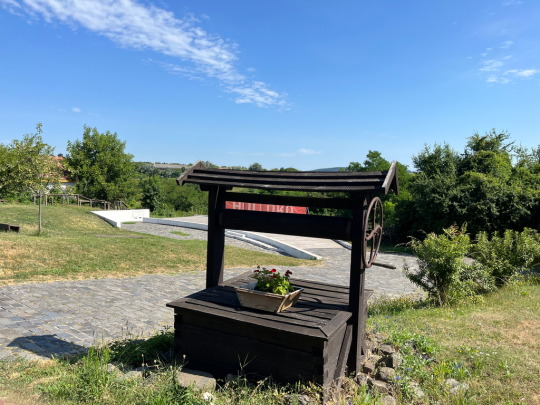
Das Dorf erwacht gerade zum Leben. Ich drehe meine Runde durch die beiden kleinen Kopfsteinpflasterstraßen und fotografiere die Häuser mit ihren ungewöhnlichen Dächern. Ich in einer guten Jahreszeit hier, überall leuchten die bunten Blumen in den Gärten und Balkonkästen .


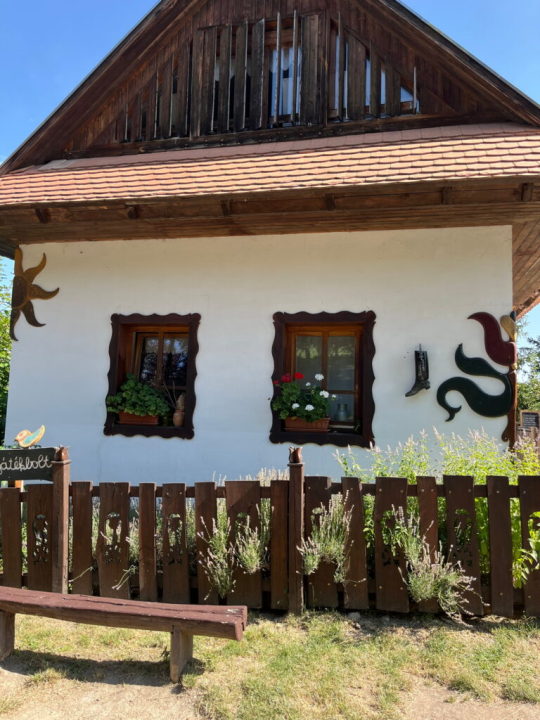


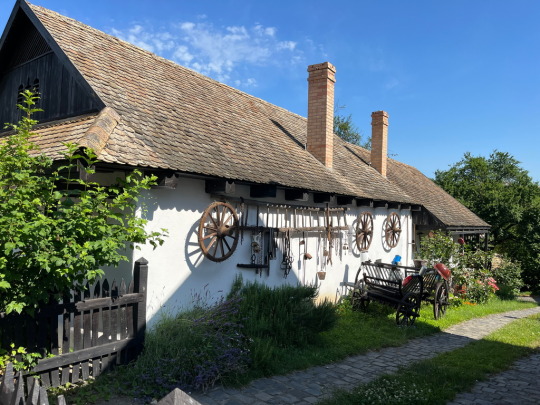




Die Häuser sind alle bewohnt und die Höfe bewirtschaftet. Es gibt darin auch viele Gästezimmer, Restaurants, Winzereien und Boutiquen, die einheimische Handwerksprodukte und Folklore anbieten. Leider sind so früh die kleine Kirche und das Dorfmuseum noch geschlossen.








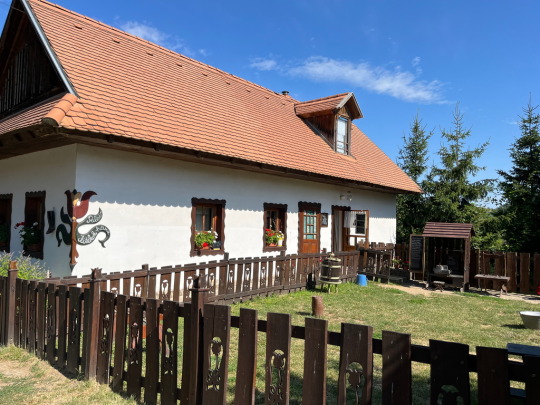

Schon von hier unten sehe ich die Burg auf dem Berg thronen und ich entdecke wenig später einen Fußweg durch den Wald.
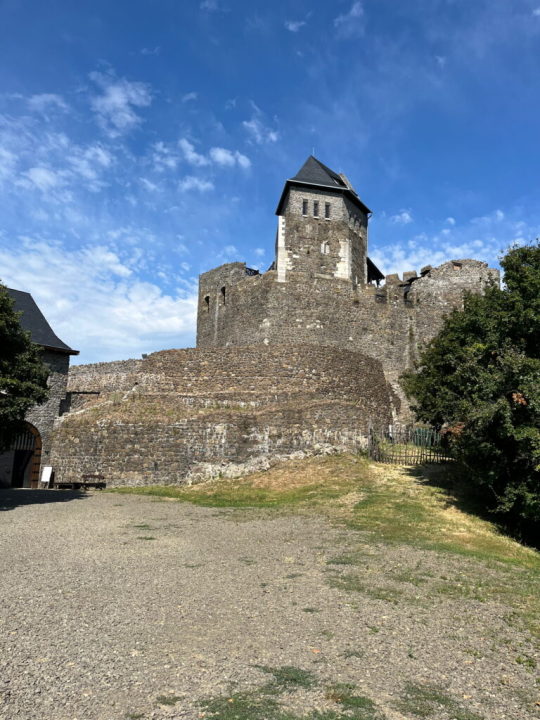
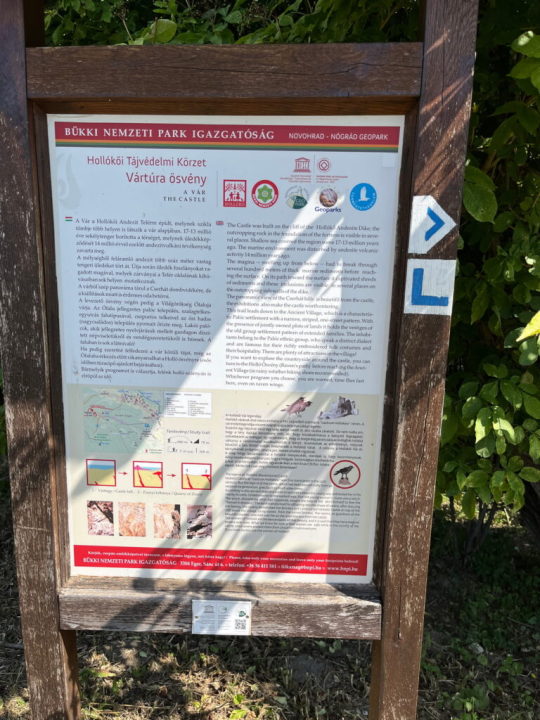
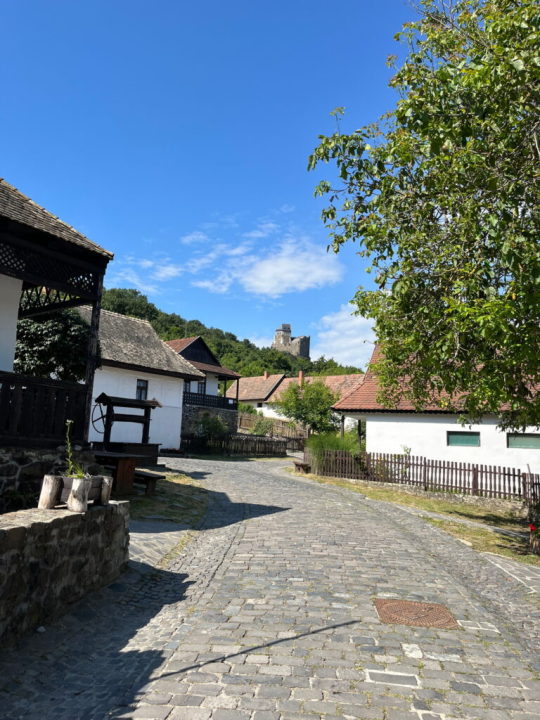
Fast 200 Stufen führen vom Eingang der Burg in die oberen Ebenen und auf den Turm. Es ist heiß, doch der Blick ins Land lohnt die Anstrengung.





In den noch erhaltenen Teilen ist ein Museum eingerichtet. Leider gibt es die vielen Informationen hier nur in ungarisch. Dafür sind die Räume mit historischen Möbeln eingerichtet und die Ausstellung selbsterklärend. Besonders gut gefällt mir, wie in den einzelnen Sälen und der Kapelle die Stimmung mit Mittelaltermusik authentisch gestaltet wird.




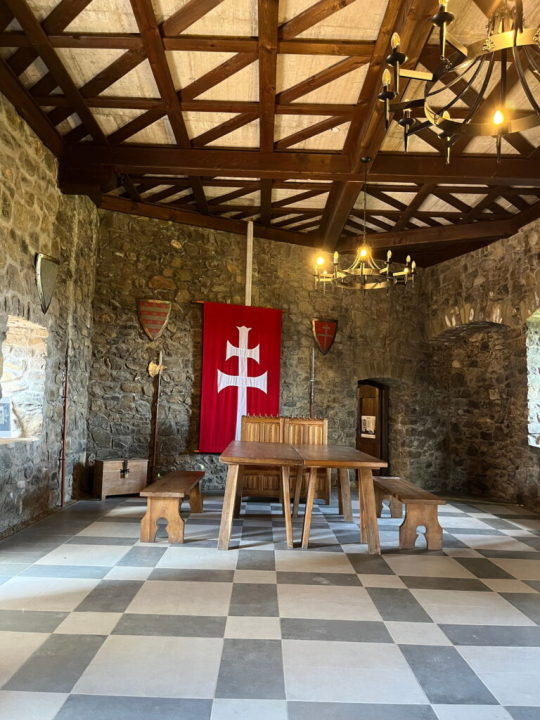
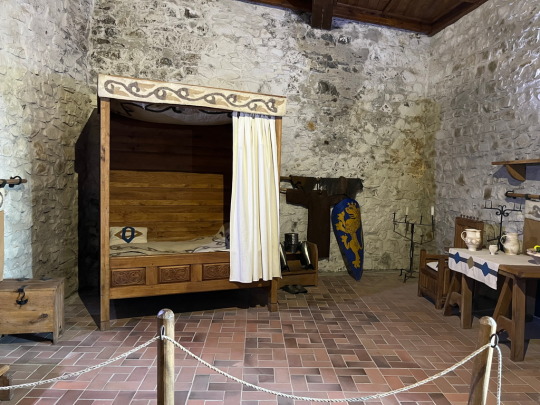

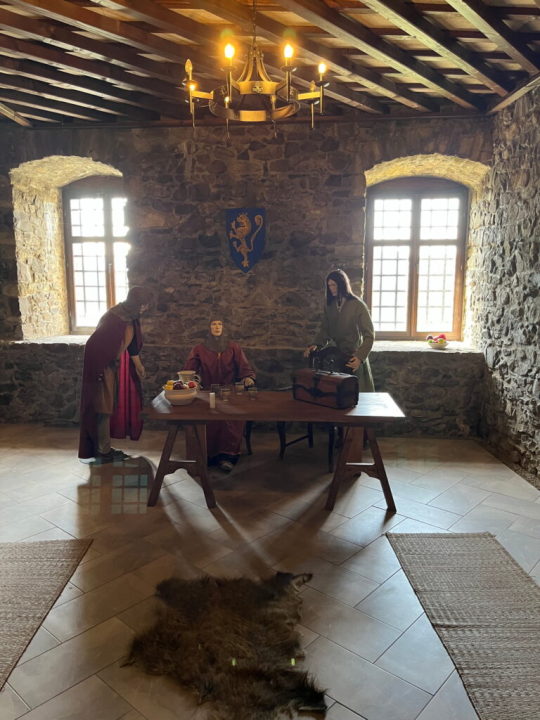

Als ich wieder nach meiner Burgbesichtigung ins Dorf zurück komme, kann ich einen Blick in die kleine Kirche werfen.
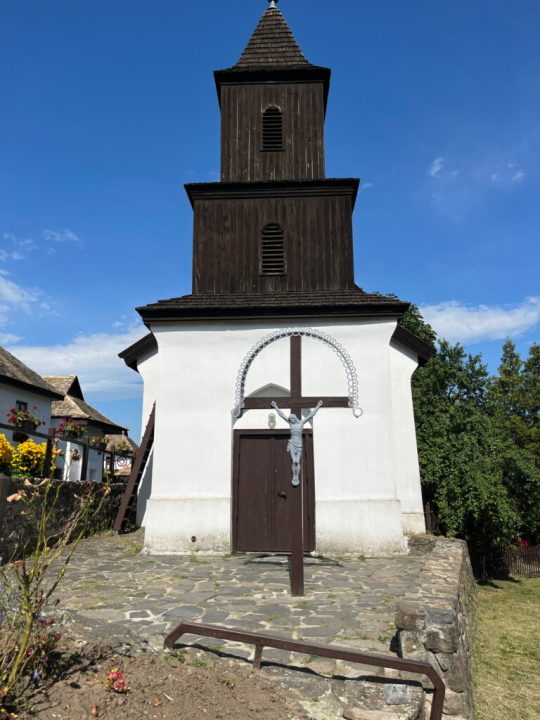


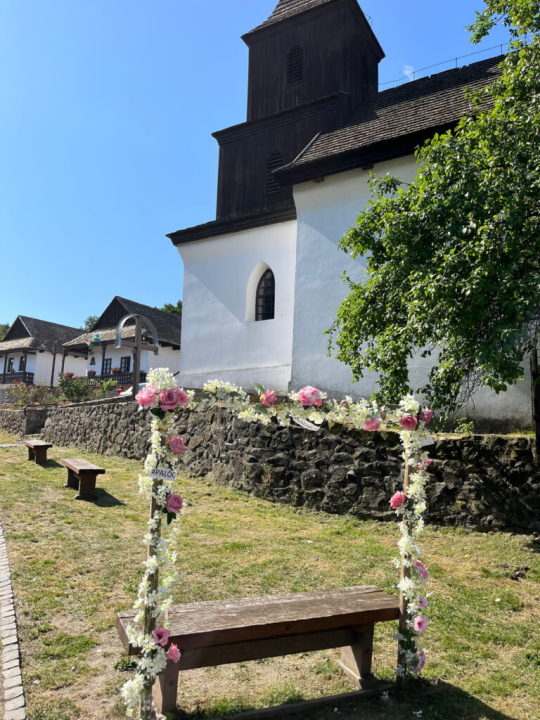

Resümee
Das Dorf Hollókő ist, zusammen mit der alten Burg und dem Wissen um seine Geschichte, durchaus einen Besuch wert. Die Landschaft lädt zum wandern ein und das Dorf zum verweilen. Wer also noch kein authentisches historisches Dorf besucht hat, an ungarischer Volkskunst und natürlich lokalem Wein interessiert ist, sollte unbedingt einmal hierher fahren. Einziger Nachteil sind die fehlenden Übersetzungen in den Beschreibungen, auch Jahreszahlen an den Häusern und einige Erklärungen wären schön gewesen.
Auf der Weiterfahrt entdecke ich dann einen imposanten Weiher und lege eine Picknickpause ein.

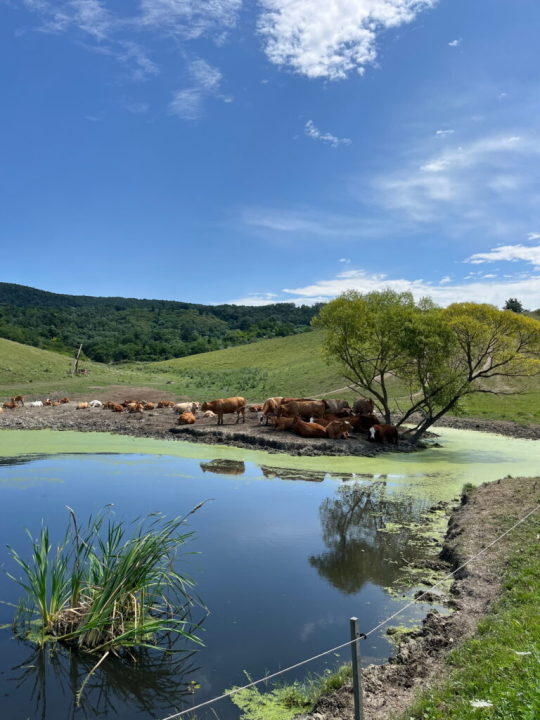
Die gesamte Tour go-south 2.0 ist hier beschrieben. Hier gehts zu meinem Welterbe-Projekt. Der Umbau meines Dacia Dokker als Minicamper ist hier detailliert nachzulesen. Dobbys nach und nach angepasste Einrichtung und Ausstattung hat sich auch in diesem megaheißen Sommer bewährt. Meine Übernachtungsplätze habe ich wieder auf park4night gesucht und unter 5Reisende bewertet.
Read the full article
#Abenteuermobil#Abenteuerreise#alleinunterwegs#Alleinreisen#Ausbau#Ausrüstung#Autoreise#Besichtigung#Camping#Camping-Mobil#Dacia-Dokker#DIY#Dobby#Erfahrungsbericht#Erkundung#Europa#Hochdach-Kombi#Hollokö#Inspiration#Leichtbau#Minicamper#Österreich#Parkplatz#Reisebericht#Reisefotografie#Reisetagebuch#Reiseziele#Roadtrip#Rundfahrt#Rundreise
0 notes
Text
Demonstration gegen staatliche Gewalt am 29.03.2023 in Jena

Gegen staatliche Repression und Gewalt: Demonstration und Protest am Mittwochabend in Jena
Am Mittwoch, den 15. März fanden in Jena und Leipzig 8 Hausdurchsuchungen statt. Der Hintergrund der Durchsuchungen ist ein Ermittlungsverfahren der Generalstaatsanwaltschaft Dresden sowie der Landeskriminalämter Sachsen und Thüringen gegen mehrere Antifaschist*innen, denen vorgeworfen wird am 13. Februar in Budapest Angriffe auf Neonazis verübt zu haben. An diesem Tag versammelten sich in Ungarn Neonazis aus ganz Europa, um die Wehrmacht, die SS und die ungarischen Kollaborateure zu glorifizieren.
➤ Weitere Nachrichten aus Jena >>
Anlässlich dieser Hausdurchsuchungen zeigten sich diesen Mittwoch am 29. März 2023 300 Menschen solidarisch und nahmen um 18 Uhr an einer Demonstration gegen Polizei und Staatsgewalt teil. Die Rufe "Solidarität muss praktisch werden - Feuer und Flamme den Repressionsbehören" erklangen laut in den Straßen Jenas.
Veranstaltungshinweis: Fototour Thüringen – Lichtmalerei an der Bockwindmühle Krippendorf im Mai
Lightpainting, Langzeitbelichtung, Nachtfotografie – Bockwindmühle Krippendorf, Fototour in Thüringen am Samstag, 20.05.2023
Die Organisator*innen riefen dazu auf sich solidarisch mit den Betroffenen der Razzien vor zwei Wochen und darüber hinaus mit allen Menschen, die strukturell von polizeilicher und staatlicher Gewalt betroffen sind, zu zeigen.

Demo gegen staatliche Gewalt am 29.3.in Jena, Foto: Libertad Media
Während die Polizei und der Staat strukturell antifaschistische und emanzipatorische Selbstorganisierung kriminalisiert, müssen organisierte Neonazistrukturen kaum mit rechtlichen Konsequenzen rechnen. Stattdessen geht die Polizei mit martialischen und rechtswidrigen Mitteln gegen Antifaschist*innen vor. Hausdurchsuchungen, die 2021 durchgeführt wurden, konnten inzwischen als rechtswidrig festgestellt werden.
➤ Veranstaltungen in Jena
Der gesellschaftliche und mediale Aufschrei dagegen lässt allerdings bis heute auf sich warten. Die Forderung nach einer lückenlosen Aufklärung des rechtswidrigen Einsatzes der Polizei und ein Ende der repressiven Gewalt gegen Antifaschist*innen wurde laut auf die Straßen Jenas getragen.
Hintergrundinfos zur Demonstration in Jena: "Nach Durchsuchungen: Solidarisch und kämpferisch auf die Straße gegen staatliche Repression!" (Beitrag auf libertad-media.de)
Die Demonstrierenden positionierten sich außerdem klar gegen die strukturelle rassistische Gewalt der städtischen Behörden, die tagtäglich gegen Menschen, die aufgrund von politischer Verfolgung oder Krieg aus ihrer Heimat fliehen mussten, ausgeübt wird. Durch die Illegalisierung von Menschen, die immer mehr zunehmende Bürokratisierung, die unzähligen Abschiebungen von Geflüchteten und mit der mörderischen Politik an den EU-Außengrenzen zeigen die staatlichen Institutionen die Fortführung und Intensivierung einer strukturell rassistischen Politik.

Am Mittwoch den 29.03.23 fand eine Demonstration „gegen staatliche Repression“ statt. 250-300 Antifaschist*innen nahmen an dem Aufzug durch die Innenstadt teil. Foto: Libertad Media
Des weiteren solidarisierten sich die Demonstrierenden mit den Klimaaktivist*innen, die am Morgen des 29.03. das Heizwerkkraft in Jena Winzerla besetzten. Sie stellten sich hinter die Forderung der Aktivist*innen gegen den weiteren Ausbau fossiler Gasinfrastruktur, der damit einhergehenden Umweltzerstörung und Ausbeutung des globalen Südens und für erneuerbare Energien und dezentrale Energieversorgung, die in der Hand der Bürger*innen selbst liegen soll. In den verschiedenen Redebeiträgen wurde deutlich, dass die Demonstrierenden feministische, antikapitalistische, antirassistische und internationalistische Kämpfe und Perspektiven miteinander verbinden und sich solidarisch gegen die strukturelle Gewalt, welche von den staatlichen Institutionen ausgeübt wird, stellen.
"Solidarität ist die Waffe, die uns niemand nehmen wird! Wir lassen uns nicht einschüchtern, sondern stehen solidarisch zusammen im Kampf für eine befreitere Welt, in der ein gutes Leben für alle möglich ist!" so eine Aktivistin.
Read the full article
0 notes
Video
Garden closed by Pascal Volk
#Berlin#Charlottenburg#Budapester Straße#Bikini Berlin#Bikinihaus#Berlin Charlottenburg-Wilmersdorf#City West#ARTinBW#schwarz#weiß#black#white#Black and White#schwarzweiß#S&W#B&W#bnw#blanco y negro#blanco-negro#Sommer#Summer#Verano#Canon EOS R#Canon RF 70-200mm F2.8L IS USM#70mm#DxO PhotoLab#DxO Silver Efex Pro#Nik Collection#Ilford Pan 100
1 note
·
View note
Photo




*

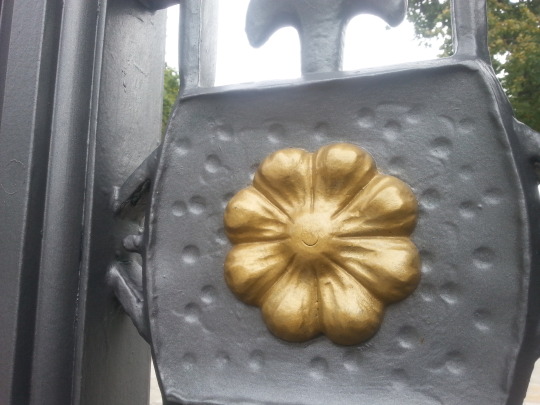
*
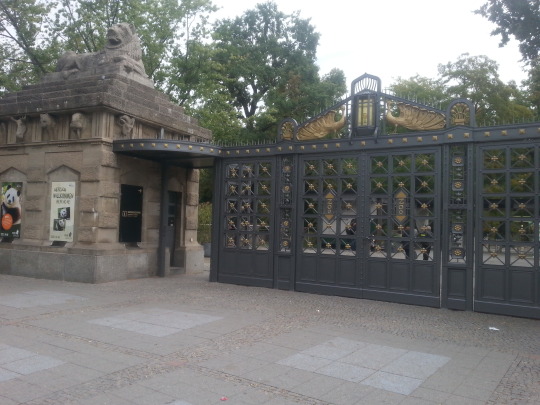

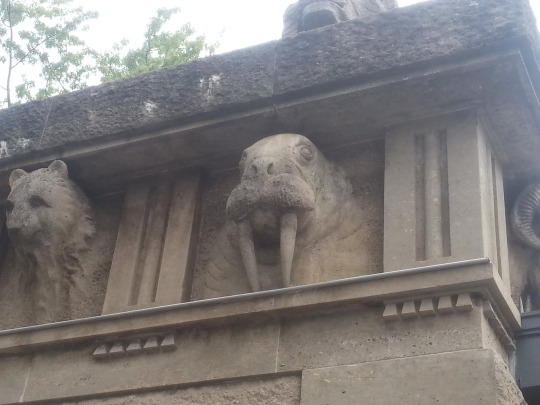
*

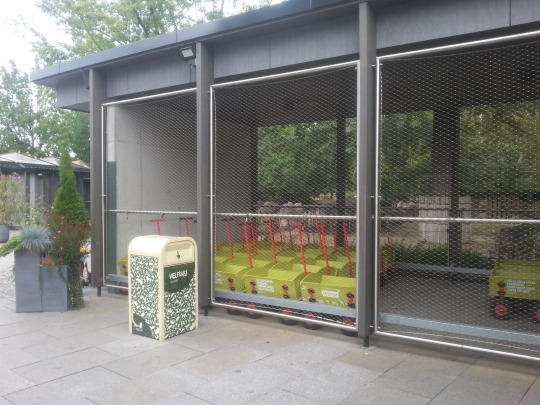
*

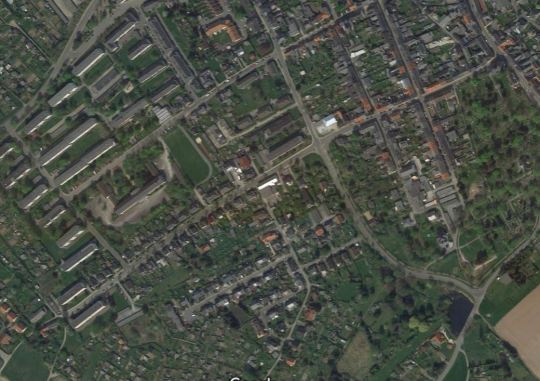
*


*

#elefantentor#löwentor#zoo berlin#gleis 1-4#bahnhof zoo#budapester straße#die gefangene des maharadscha#kadewe#zeulenroda#zeulenroda-west#busbahnhof#drahtweberei#brunnenstraße#uk#der bildverlust#mein bildarchiv#hardenbergplatz#caritas#bad+joe
1 note
·
View note
Photo

Punkthochhäuser Budapester Strasse- Erfurt Nord 07.03.2019
12 notes
·
View notes
Photo
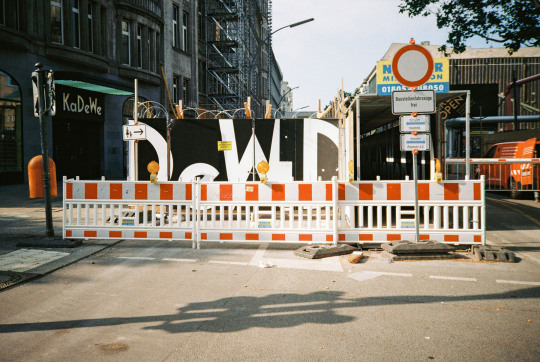
Budapester Straße, Charlottenburg, Berlin, 2021
#theinvisiblewall#berlin#glogauair#artistinresidence#virtualopenstudios#virtualresidency#onlineresidency#budapester straße#charlottenburg
0 notes
Photo

Die Kanten. / 12.12.2018
6 notes
·
View notes
Photo

0 notes
Photo

Quarentine Diaries: Budapester straße
#budapesterstrasse #berlin #deutschland #germany #europe #architecture #arquitectura #arquitetura #StreetPhotography #StreetPhotographyInColors #IG_StreetPhotography #StreetPhotographyCommunity #StreetPhoto #PeopleInFrame #PhotoDocumentary #StreetPhotographyInternational #StreetPhotographyWorldwide #CandidShots
.
.
.
.
.
Made with ❤ & @photoshop .
0 notes
Text
Welterbe (auf)gespürt und (er)fahren – D, AT, HU, BG, RO – Back from the South 2.0

Während Deutschland wochenlang bei herbstlichen Temperaturen im Regen versunken ist, bin ich fast 7.000 km bei sengender Hitze durch unsere südlichen Nachbarländer zu 36 Welterbestätten, teils mit mehreren Komponenten, unterwegs gewesen. Meinen ursprünglichen Plan, im Anschluss an Bulgarien noch nach Griechenland zu fahren, habe ich wegen der vielen Waldbrände in diesem wohl bisher heißesten Juli verworfen und werde mich stattdessen im September auf eine Herbstreise durch die westlichen Balkanländer begeben.

In Vorbereitung auf diese Welterberunde musste ich mich neben dem Tourenplan auch mit den vielen unterschiedlichen Mautsystemen befassen.
Von Österreich kommend gab es eine rasante Änderung des Fahrstils. Während die Ösis ausgesprochen ordentlich fahren, sind die Ungarn recht sportlich unterwegs. Autofahren in Rumänien ist dagegen anstrengend und zeitraubend. Es gibt nur zwei Arten von Straßen, entweder in Serpentinen über Berge oder durch endlose, aneinandergereihte Orte, dazu die regel- und zügellosen Autofahrer und Kühe, Schafe, Hunde und Katzen. Aber ich habe dafür noch nie so viele Störche gesehen wie in Rumänien, in jedem Dorf gibt es mehrere Nester. In Bulgarien fühlte ich mich wieder wohler auf der Straße und habe überhaupt dort die nettesten Leute der ganzen Route getroffen.
Doch genug der Vorrede, ich habe auf dieser tollen Runde wieder einmalige, wunderschöne und interessante Orte gesehen. Hier sind meine besuchten Welterbestätten, die ich in bewährter Art und Weise im Einzelnen beschreiben und die Beiträge hier verlinken werde. Wer mir auf Instagram - @dobbystories folgt, wird schon einige Eindrücke meiner Besuche gesehen haben.

In Deutschland habe ich einige Zeugen der Grenzen des Römischen Reiches besichtigt, und zwar am
- Obergermanisch-Rätischen Limes und
- Donaulimes
Österreich hielt eine Fülle unterschiedlicher Welterbestätten für mich bereit. Das historische Zentrum von Wien hatte ich bereits 2020 auf meiner Tour nach Budapest besucht. Auf dieser Runde habe ich die anderen österreichischen Welterbe gesehen:
- das historische Zentrum von Salzburg
- die Pfahlbauten am Mondsee
- die Kulturlandschaft Hallstatt-Dachstein im Salzkammergut
- das historische Zentrum von Graz und Schloss Eggenberg
- die Semmeringbahn

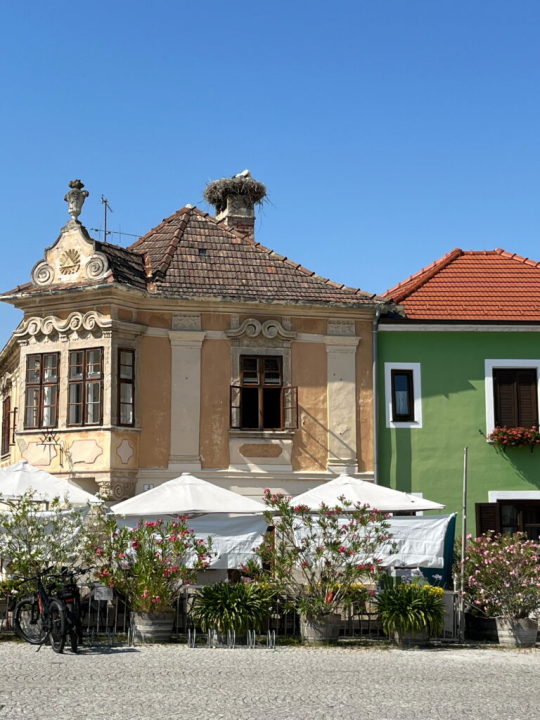
- die Kulturlandschaft Wachau
- Schloss und Gärten Schönbrunn
- das Wildnisgebiet Dürrenstein
- das Heidentor in Petronell Carnutum
- die Kurstadt Baden bei Wien und
- die Kulturlandschaft Neusiedler See
In Ungarn habe ich auf meiner Tour 2020 bereits das historische Zentrum von Budapest und den Nationalpark Hortobágy - die Puszta sowie die Landschaft um den Balaton besucht, auf dieser jetzt die folgenden Welterbestätten:
- die Kulturlandschaft Fertö/ Neusiedler See
- die Benediktinerabtei Pannonhalma
- das alte Dorf Hollokö
- die Aggteleker Karsthöhlen
- die historische Kulturlandschaft der Weinregion Tokaj
- die frühchristliche Necropole von Pecs
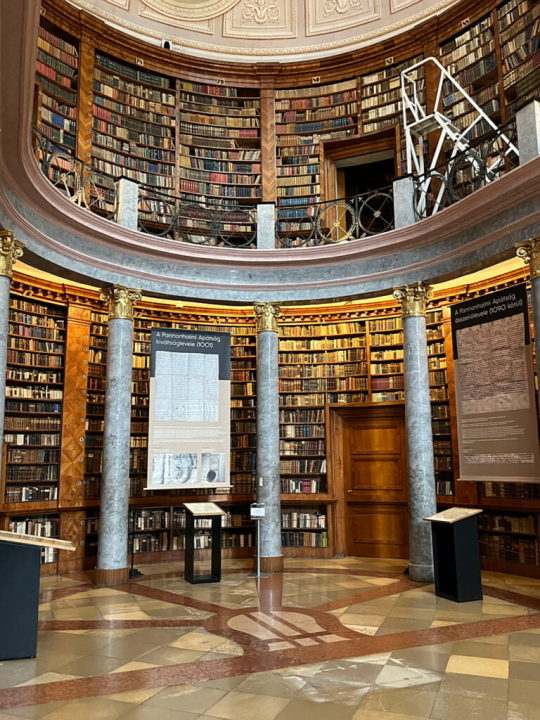
In Rumänien gab es ebenfalls Vieles zu entdecken, wobei ich nicht ins Donaudelta gefahren bin, weil es unmittelbar an der Grenze zur Ukraine liegt. Besucht habe ich aber:

- die Holzkirchen von Maramures
- die Moldauklöster
- die Kirchenburgen in Siebenbürgen
- das historische Zentrum von Sighisoara
- die Bergbaulandschaft Rosia Montana
- die Dakischen Festungen im Orastie-Gebirge
- das Kloster Horezu
Meine Runde durch Bulgarien war ebenfalls wunderbar und abwechslungsreich. Ich konnte die folgenden Welterbestätten sehen:
- die Felsenkirchen von Iwanowo
- das Naturschutzgebiet Srebarna
- das Thrakische Grab von Sweschtari
- der Madara-Reiter
- die Pobiti Kamani
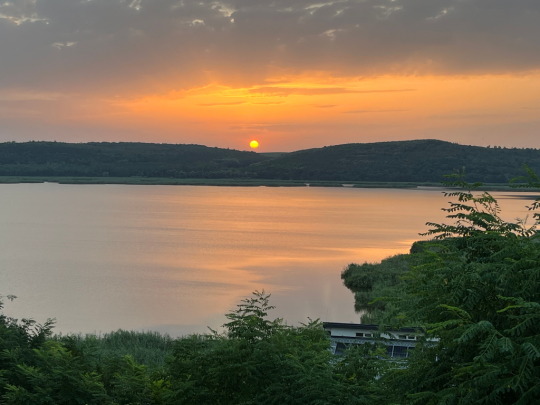
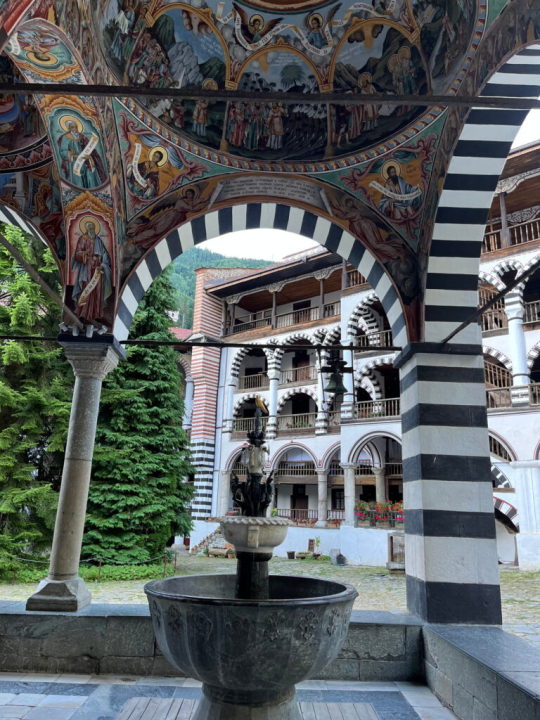
- die Antike Stadt Nessebar
- das Thrakische Grab von Kazanlak
- der Nationalpark Zentralbalkan
- die Boyana-Kirche
- das Rila-Kloster und
- der Pirin-Nationalpark
Gerade stört mich der Regen nicht, denn ich freue mich auf die Durchsicht der Fotos und das Schreiben der Blogbeiträge und würde mir wünschen, dass meine Berichte Anregungen für einen Besuch der einen oder anderen Stätte geben.
Die gesamte Tour go-south 2.0 ist hier beschrieben. Hier gehts zu meinem Welterbe-Projekt. Der Umbau meines Dacia Dokker als Minicamper ist hier detailliert nachzulesen. Dobbys nach und nach angepasste Einrichtung und Ausstattung hat sich auch in diesem kalten und nassen Frühjahr bewährt. Meine Übernachtungsplätze habe ich wieder auf park4night gesucht und unter 5Reisende bewertet.
Read the full article
#Abenteuermobil#Abenteuerreise#alleinunterwegs#Alleinreisen#Ausbau#Ausrüstung#Autoreise#Besichtigung#Bulgarien#Camping#Camping-Mobil#Dacia-Dokker#Deutschland#DIY#Dobby#Erfahrungsbericht#Erkundung#Europa#Hochdach-Kombi#Inspiration#Leichtbau#Minicamper#Österreich#Parkplatz#Reisebericht#Reisefotografie#Reisetagebuch#Reiseziele#Roadtrip#Rumänien
0 notes
Text

Dresden, 14. August 2018.
0 notes
